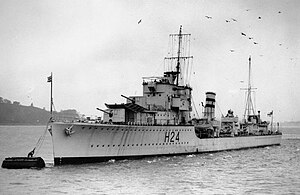
Back Třída G a H Czech G-Klasse (Royal Navy) German G-luokka (hävittäjä) Finnish Classe G et H French Classi G e H (cacciatorpediniere) Italian G級駆逐艦 (2代) Japanese Niszczyciele typu G/H Polish Эскадренные миноносцы типов G и H Russian Ескадрені міноносці типу G та H Ukrainian Lớp tàu khu trục G và H Vietnamese
 HMS Hasty in 1936
| |
| Class overview | |
|---|---|
| Operators | |
| Preceded by | E and F class |
| Succeeded by | I class |
| Subclasses | G, H, Havant |
| Built | 1934–1940 |
| In commission | 1936–1964 |
| Completed | 24 |
| Lost | 17 |
| Scrapped | 7 |
| General characteristics (G- and H-class as built) | |
| Displacement | |
| Length | 323 ft (98.5 m) (o/a) |
| Beam | 33 ft (10.1 m) |
| Draught | 12 ft 6 in (3.8 m) |
| Installed power |
|
| Propulsion | 2 shafts; 2 geared steam turbines |
| Speed | 35.5 knots (65.7 km/h; 40.9 mph) |
| Range | 5,530 nmi (10,240 km; 6,360 mi) at 15 knots (28 km/h; 17 mph) |
| Complement | 137 (peacetime), 146 (wartime) |
| Sensors and processing systems | ASDIC |
| Armament |
|
| General characteristics (Havant class, where different) | |
| Armament |
|
| General characteristics (Grenville & Hardy, where different) | |
| Displacement |
|
| Length | 330–337 ft (100.6–102.7 m) (o/a) |
| Beam | 33.75–34 ft (10.3–10.4 m) |
| Installed power | 38,000 shp (28,000 kW) |
| Complement | 175 |
| Armament | 5 × single 4.7 in (120 mm) guns |
The G- and H-class destroyers were a group of 18 destroyers built for the Royal Navy during the 1930s. Six additional ships being built for the Brazilian Navy when World War II began in 1939 were purchased by the British and named the Havant class. The design was a major export success with other ships built for the Argentine and Royal Hellenic Navies. They were assigned to the Mediterranean Fleet upon completion and enforced the Non-Intervention Agreement during the Spanish Civil War of 1936–1939.
Most ships were recalled home or were sent to the North Atlantic from October–November 1939, after it became clear that Fascist Italy was not going to intervene in World War II. Then they began to escort convoys and patrol for German submarines and commerce raiders. Two ships were lost to German mines in the first six months of the war. Three more were lost during the Norwegian Campaign, one in combat with a German cruiser and two during the First Battle of Narvik in April 1940. The Battle of France was the next test for the destroyers from May–June, with many of the Gs and Havants participating in the evacuation of Dunkirk and the subsequent evacuations of Allied troops from western France. Three ships were sunk, two by bombs and the other to torpedoes. Most of the H-class ships were sent to the Mediterranean in May in case Mussolini decided to attack France and the majority of the surviving Gs were sent to Force H at Gibraltar in July. Two of them, Griffin and Greyhound, participated in the Battle of Dakar, before being assigned to the Mediterranean Fleet with their sister ships. By the end of the year, the ships participated in several battles with the Royal Italian Navy, losing two to Italian mines and torpedoes, while sinking two Italian submarines. The Havants spent most of the war in the North Atlantic on convoy escort duties, losing half their number to German submarines, while helping to sink six in exchange by the end of the war.
The G- and H-class ships of the Mediterranean Fleet escorted numerous Malta convoys, participated in the Battle of Cape Matapan in March 1941 and covered the evacuation of troops from Greece and Crete from May–June, losing two to German bombers and another so badly damaged that she was later written off. By the end of the year, they had sunk three submarines, two Italian and one German. Three Hs participated in the Second Battle of Sirte in March 1942, during which one was damaged. Further damaged by aerial attacks, she was ordered to Gibraltar and ran aground in transit and had to be destroyed. Another was torpedoed and lost during Operation Vigorous in June. The ships sank two more submarines during 1942 and three destroyers began conversion to escort destroyers late that year and early in 1943. Two of the four surviving Gs and Hs were transferred to the Royal Canadian Navy (RCN) while under conversion. All of the surviving ships joined their Havant half-sisters on escort duty in the North Atlantic in 1943.
One ship was sent to the Mediterranean in 1944 while three others were transferred to the UK in preparation for Operation Overlord. Between them they sank five German submarines in 1944 with another in 1945. Worn-out and obsolete, the survivors were either broken up for scrap or sold off after the war.